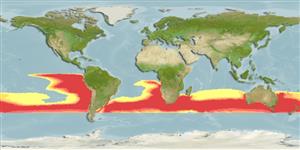Preferred temperature (Ref.
123201): 10.2 - 19.1, mean 14 °C (based on 193 cells).
Phylogenetic diversity index (Ref.
82804): PD
50 = 0.5039 [Uniqueness, from 0.5 = low to 2.0 = high].
Bayesian length-weight: a=0.00891 (0.00403 - 0.01972), b=3.10 (2.91 - 3.29), in cm total length, based on LWR estimates for this (Sub)family-body shape (Ref.
93245).
Nível Trófico (Ref.
69278): 4.2 ±0.57 se; based on food items.
Resiliência (Ref.
120179): Baixo, tempo mínimo de duplicação da população 4,5 - 14 anos (Preliminary K or Fecundity.).
Fishing Vulnerability (Ref.
59153): High vulnerability (60 of 100).
🛈
Nutrients (Ref.
124155): Calcium = 18 [7, 40] mg/100g; Iron = 0.301 [0.138, 0.809] mg/100g; Protein = 18.9 [16.9, 20.8] %; Omega3 = 0.176 [0.072, 0.406] g/100g; Selenium = 15.4 [5.8, 39.5] μg/100g; VitaminA = 25.9 [3.5, 202.1] μg/100g; Zinc = 0.375 [0.213, 0.736] mg/100g (wet weight);
